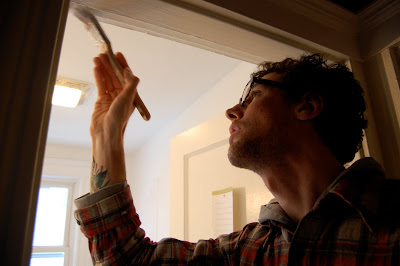We decided on doing a painted burlap wall covering paired with a strie glaze trim. It took us about a week since we allowed drying time overnight between steps. If you're interested in trying it yourself, here's how it's done:
First, apply a wallpaper primer to the walls and let it dry overnight. Measure the walls that need to be covered with the burlap, then cut the fabric to size. Store the burlap carefully so it doesn't fray, or you will be annoyed with yourself.

Very thickly apply heavy duty, clay-based wallpaper paste to the wall's surface. It should be noisy and sound a little bit rude: squelch, squelch, squelch! Cut into the corners and edges first.

You want to get the burlap up on the wall when the wallpaper paste is at its freshest and wettest, so it's a good idea to work in small sections. You can use a roller on the larger areas.

We highly recommend getting a resident kitty to come supervise this next burlap part, 'cause it can get a little tricky.


Tuck the burlap up to the ceiling and into the corners first, then smooth it out towards the middle of the wall. Make sure you smooth out every square inch, you don't want any pockets of burlap that don't get stuck to the wall!

You'll need to make sure the seams on the burlap match up nicely with no overlap, otherwise you'll get a too-lumpy finish when it's plastered over later.

A flat-edged tool is a good thing to have on hand to tuck in the burlap without getting your hands too messy (although, full disclosure: they will get messy).

For holes and fixtures, like this satanic-looking space for a medicine cabinet, place the burlap straight over it and later cut the hole out. Avoid looking directly into its eyes.

This is what your completed burlap stage should look like. Make sure the kitty inspects it for quality (and by the way, plug up any holes and keep the door shut so no critters can get stuck!). Let the paste and burlap dry overnight.

Once it's all dry and you get the go ahead from the kitty, start plastering using a flat-edged tool. Just like when you prime and paint a normal wall, you should cut into the corners and edges with the plaster first.

Wrapping a rag around the handle of the tool can help prevent blisters. Help. There's no guarantee here. :)

This is what the plastered burlap looks like after drying overnight. Is that a scary hole, or what?!

Now you can treat the burlap covered wall just as you would any other surface you're going to paint. Use a good quality primer to cover the plaster.

While that's drying (usually a few hours--more or less depending on your climate and the season), take a break and entertain those kitties, will you?


Next, you can go ahead and paint the walls in the color that will serve as the base for your design. Before your final coat of paint, be sure to caulk in any seams, like where the chair rail meets the wall, any corners, and where the wall meets the ceiling. Before we begin the stenciling, we like to finish the trim.

Prime and paint the trim as you normally would, then let it dry. You can buy pre-mixed colored glazes, but we can't in good conscience recommend them! You'll get much better results when you mix your own glaze and tint.


When the paint is dry, apply the glaze with a standard 2" painting brush.

Use a strie brush to get a nice lined effect; they're available in the Boston area at Johnson Paint Co. on Newbury Street, a favorite supplier of ours.

Working top to bottom, run the strie brush through the glaze to get a striped effect.

While the glaze is still wet, drag a piece of steel wool through it to create a specking texture as a finishing touch on the trim. There's a variety of grades of steel wool. Choose the grade according to effect you'd like to achieve; the rougher the steel wool, the rougher the texture.

Now you're ready to apply the water-based paint colors with the stencil design. Put a small amount of paint on a stencil brush (also available at Johnson Paint Co.), then work the brush into the pallet in a swirling motion, saturating the brush with paint without straight up dunking it. If there's too much paint on the brush, it will leak under the edge of the stencil.

Use painter's tape to put the stencil in place. Using the same swirling motion you used on the pallet, apply the paint onto the wall through the stencil.

You can remove the stencil immediately. Because of the texture of the burlap, you may find that some paint has leaked under the stencil. Don't panic, you can just touch it up later. I guess you can panic if you really want to, but you'll still just be touching it up later and you'll probably be tired from your panic attack.
True to Chroma Lab fashion, we used lots of bright colors, making the drops visually heavier at the top, and thinning them out near the bottom of the wall. Here's how it turned out:

One of our clocks fit perfectly into the color scheme, so we left it as a little surprise for our clients.

Their cute and colorful towels are by Marimekko (although that specific style is no longer available--too bad!).



Hope you like the pictures and how-to! We are considering beginning a series of instructional classes for wall treatment application and color mixing techniques. Would anyone in the Boston area be interested in that?






12 comments:
I am interested! This is such a cool process. I get the step by step that you posted, but I would love to get a hands on! :)
Yes, yes, yes!
I would! This bathroom looks great :)
Yes, me too! Now that I have it in my bathroom, I need to learn it!
So nice to share, great thing! - came over via Hello Tiger, would like to show it in my blog as well! may I?
Colelatimer, Paige, Swati, and Ila--great! So glad to hear it. Happily we ARE going to offer classes! We're working on the plans and we'll be sure to get in touch with you.
Thank you for re-posting our work, Tiger! Dolores, of course, feel free to put it on your blog with a link back here. :)
Ila, I guess that's the only problem with taking the vacation while we're working, ha!
this is so cool! i would love to take a class but am nursing a wee babe at the moment, how long do you think the classes would run? also why use burlap on the wall, for texture? excellent tutorial. you could also do online tutorials and charge a fee for this as well...for those of us who may not be able to get to a real class. is this okay to repost to my blog? i am in love with your choice of colors, bravo!
Thanks for sharing. That was very generous of you. You make it look so easy. But, I'm savvy enough to know how hard you worked. And the end product shows it.
Liz, we're not sure when we will begin teaching the classes or how long they will last when we do. I like the online tutorial idea. Please feel free to repost this to your blog, thanks!
You're right, burlap lends a great texture to a wall. Covering it with plaster and paint allows us to customize colors and designs, and it also seals the fabric so no moisture can penetrate, which is good news in a bathroom.
---
Thanks for your kind words and recognizing how much work goes into what we do. Coming from a Quiltmaster, it means a lot!
fabulous. I would be interested too!
I'm from Brasil...
I loved it!
Very, very nice!!!
This looks GREAT! I guess there is no way to really minimize the bulky seams where the folded edges of the fabric meet? And how wide was the burlap you used? If one finds it in different widths, is there one which you feel is most manageable? Another site -- not that you should care! -- recommented using 2' wide strips...but that would just increase all the seams : (
Post a Comment